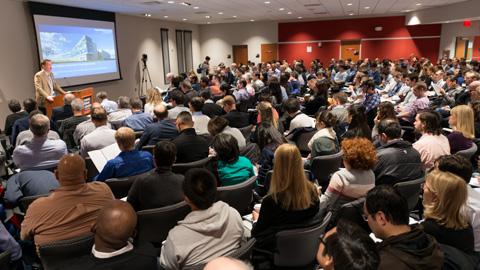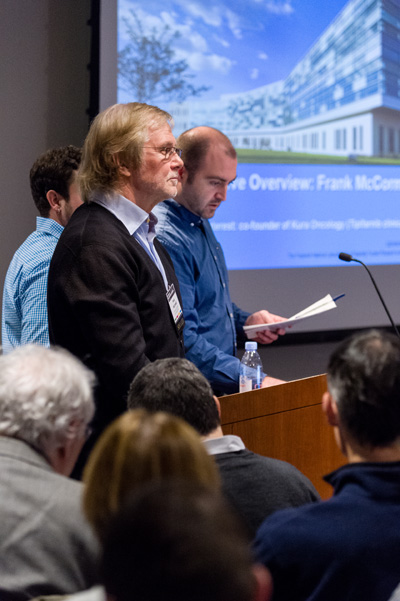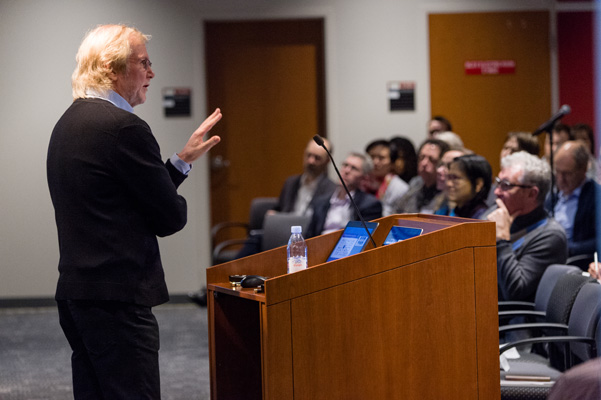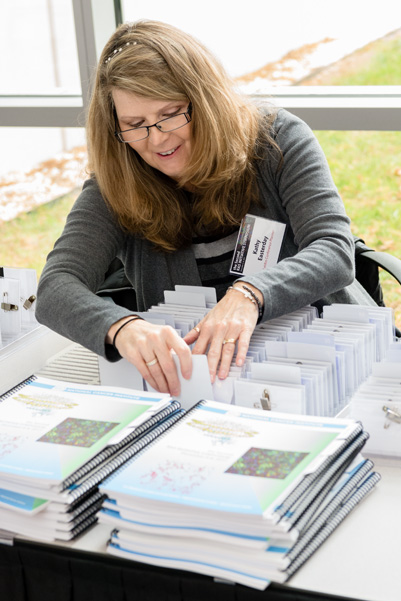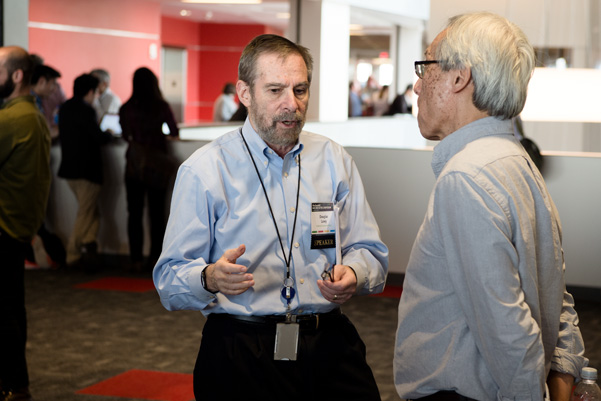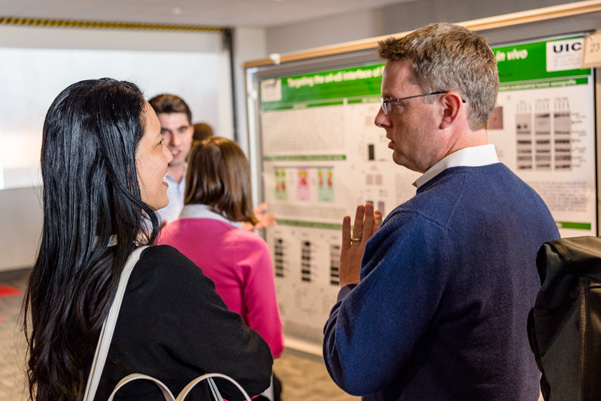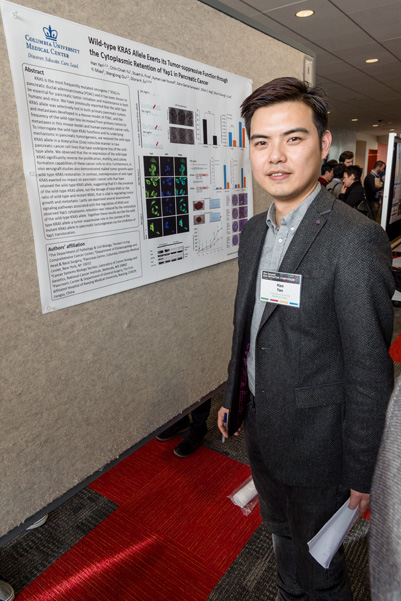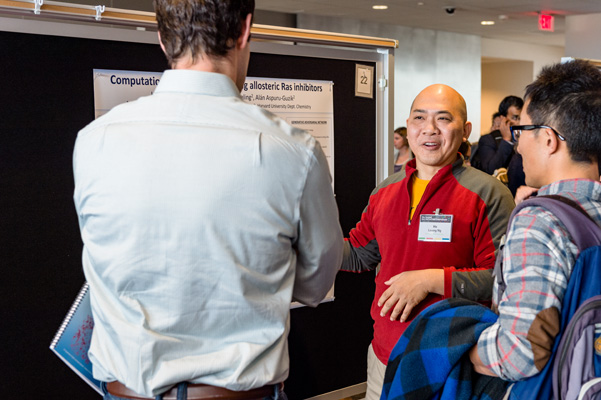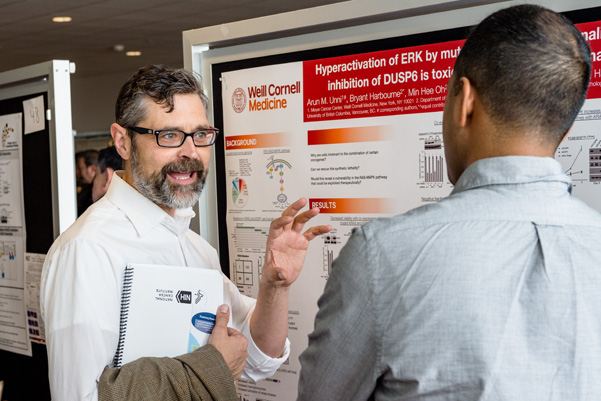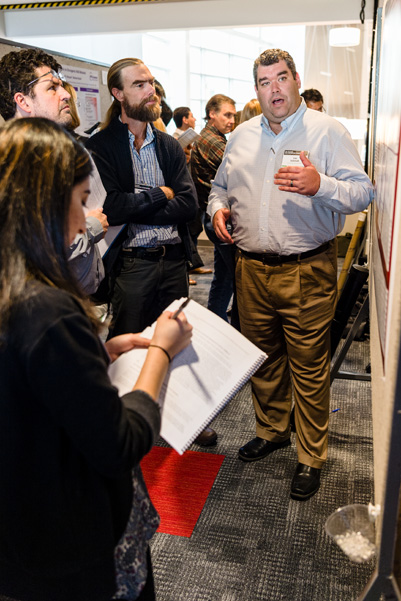From December 6–8, the Advanced Technology Research Facility of the Frederick National Laboratory for Cancer Research (FNLCR) was abuzz with conversation and collaboration as nearly 450 scientists, academics, and industry partners gathered for the Second RAS Initiative Symposium.
Attendees hailed from 14 nations, dozens of institutions, and diverse scientific backgrounds, but they shared a common purpose: to present and discuss their research on RAS genes and cancer.
For more than three decades, scientists have known that mutations in RAS genes drive over 30 percent of all human cancers, including nearly all pancreatic cancers, making the three most commonly mutated RAS genes—KRAS, HRAS, and NRAS—and their accompanying proteins high-profile targets.
However, treating them isn’t so easy: RAS-mutant cells dodge the human body’s natural programming for killing “bad” cells, while the structures of RAS-mutant proteins have led some scientists to deem them “undruggable.” To address these challenges, RAS researchers have collectively sought to advance the field of RAS science through increased collaboration.
With that in mind, the RAS Symposium, hosted by the NCI RAS Initiative, featured three days of lectures spanning the breadth of RAS research as well as two poster sessions where attendees could learn about their peers’ work in more detail.
NCI Director Norman Sharpless, M.D., initiated proceedings on the first day and offered a few welcoming remarks, calling himself a “real lover of RAS biology” who appreciates the RAS Initiative and believes that “it’s obviously been a success.”
“There are some really great things in the National Cancer Institute, and this is one of them,” he said.
He also paused to thank both the former director of FNLCR, David Heimbrook, Ph.D., as well as his successor, Ethan Dmitrovsky, M.D., for their leadership of the Frederick National Lab, the headquarters of the RAS Initiative. Frank McCormick, Ph.D., a RAS expert and the head of the RAS Initiative, also received Sharpless’ gratitude for fostering the Initiative’s continued success.
Amid the levity and the enthusiasm, however, Sharpless reminded the attendees of the importance of their work and the magnitude of their task.
“I’d like to leave a challenge,” he said. “As clearly successful as this endeavor’s been to date, we need RAS therapies. We need great ideas that translate into people.”
McCormick then assumed the podium to deliver the keynote address, which, he informed the audience, aimed to encourage discussion and partnerships by summarizing aspects of the Initiative and introducing some of its leaders.
He explained that the Initiative is organized in a “hub-and-spoke” model in which the FNLCR serves as the “hub” while partners in colleges and universities, industry and biotech groups, and governmental institutions and national labs act as its “spokes.”
“I’ve been really gratified by the response of the whole RAS community and their willingness to collaborate and help … to make this a success,” he said.
McCormick continued by outlining some of the Initiative’s major collaborations, which include an ongoing exchange between NCI, FNLCR, the Department of Energy (DOE), and Lawrence Livermore National Lab to study RAS proteins and their binding partners at the atomic level, as well as a standing partnership with the K-Ras Synthetic Lethal Network to find genes necessary for KRAS protein creation.
He also described the Initiative’s current goals and highlighted the work of various members, including analyzing the structure of active and inactive RAS proteins, developing new methods for studying and modeling RAS interactions and states, and screening for new RAS inhibitors—compounds that limit RAS’ activity, making them useful tools for RAS studies or potential therapeutics.
Of course, that is only a fraction of the efforts undertaken by the Initiative and the scientific community. Over the course of the symposium, attendees received an in-depth view of current RAS research as 37 lecturers explained their work and addressed questions from peers in the audience.
Day One: Mutations, Membranes, and Models
Following McCormick’s speech, Stanford University’s Calvin Kuo, M.D., Ph.D., began the lecture series with a short presentation on using organoids—three-dimensional in vitro tissues that resemble “mini-organs”—to study RAS-mutant tumor development. Three more lectures rounded out the morning by discussing ways that RAS may drive the development of cancer, ranging from cell signaling to metabolism alterations to mutations that affect RAS protein function.
After a break for lunch and the day’s poster session, the attendees reconvened for three researchers’ lectures about how RAS proteins interact with other compounds and proteins at the cell membrane, the site of RAS protein activity in cells. The presenters believe their work, which included studies of enzymes and RAS inhibitors, provides an improved understanding of RAS protein biology.
The day’s final presentations explained multiple biological and computational models for simulating RAS protein interactions at the cell membrane. Of note was a presentation on current research that harnesses extreme-scale supercomputing to study RAS biology at the membrane, which is part of the NCI-DOE partnership aiming to accelerate cancer research.
Day Two: Scrutinizing Tumor Biology
The second day opened with presentations about the dynamics of RAS-mutant tumors—the mechanisms by which they form, grow, and persist. While much of the attention was on enzymes in RAS tumors, proteins were also reviewed. In the next set of lectures, two researchers analyzed the role of RAF, a group of enzymes that interact with RAS proteins, in RAS-mutant cancers.
The morning concluded with three presentations on cell signaling and RAS effectors—proteins and enzymes that bind with RAS proteins to transmit signals that cause cellular functions such as growth and proliferation.
Each of the three presenters examined different facets of RAS–effector interactions, but their work shared the idea that “shutting down” effectors in RAS-mutant cells may be useful for cancer treatment. In some cases, tumor shrinkage can occur because RAS-mutant proteins can no longer transmit a cancer-driving signal. In others, the missing effectors may make the mutant cells susceptible to destruction by immunotherapy.
After lunch and the symposium’s second poster session, the attendees again gathered to hear a round of lectures about systems biology approaches to screening for vulnerabilities in RAS-mutant cancers. Techniques ranged from using genetic dissection to identify the effectors that RAS proteins depend on, to identifying parts of RAS genes necessary for mutant cell survival, to comparing anti-RAS drug effects in healthy and mutant organoids.
Day Three: “Undruggable” No More?
Three lecturers began the final day by explaining approaches for treating RAS-mutant tumors and RAS-related diseases in a clinical setting, with a special focus on therapeutic strategies—especially immunotherapy—that can be employed alongside or in place of chemotherapy.
According to the lecturers, immunotherapies, such as T-cell therapy or combined tumor antigen vaccines and immune-cell modulation, advance RAS cancer treatment because they are more tumor-specific than chemotherapy, making them more effective at targeting tumors and less toxic to the rest of the patient’s body.
The morning’s final group of lectures shifted the conversation toward systems and tools for modeling RAS cancers. Over the next hour, three researchers introduced an array of analytical methodologies, such as using engineered enzymes that mimic effectors, studying the amplitude and frequency of RAS effector signaling in mutant cells, and attaching molecular tags to RAS proteins to validate RAS-related targets and binding events.
During the two afternoon sessions, six lecturers described current experimental RAS therapies and investigational new drugs, approaches that include DNA molecules, RAS inhibitors, and synthetic drug compounds. In most cases, the lecturers reported that their treatments have shown promising results in preclinical tests, and, while they acknowledged that further testing and clinical trials are needed, many felt encouraged by what they had seen so far.
“RAS is not at all undruggable,” argued lecturer Geoffrey Clark, Ph.D., associate professor at University of Louisville, capturing the theme of the afternoon.
After the final presentation concluded, McCormick offered a few words to close the symposium. Based on what he had seen, he said, he believes that RAS therapies will be tested in human clinical trials within two years. If the new partnerships forged during the symposium and the growing collaborative efforts in RAS research are any indication, he is right to be hopeful.


